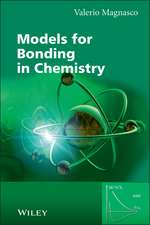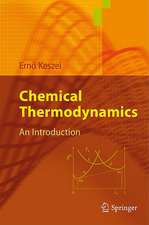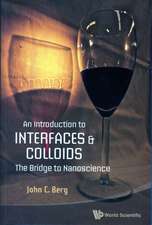Electrochemistry of Solids: An Introduction: Inorganic Chemistry Concepts, cartea 7
Autor Hans Rickerten Limba Engleză Paperback – 7 dec 2011
Preț: 388.13 lei
Nou
Puncte Express: 582
Preț estimativ în valută:
74.28€ • 76.96$ • 61.99£
74.28€ • 76.96$ • 61.99£
Carte tipărită la comandă
Livrare economică 21 martie-04 aprilie
Preluare comenzi: 021 569.72.76
Specificații
ISBN-13: 9783642683145
ISBN-10: 3642683142
Pagini: 256
Ilustrații: XII, 240 p.
Dimensiuni: 170 x 244 x 13 mm
Greutate: 0.42 kg
Ediția:Softcover reprint of the original 1st ed. 1982
Editura: Springer Berlin, Heidelberg
Colecția Springer
Seria Inorganic Chemistry Concepts
Locul publicării:Berlin, Heidelberg, Germany
ISBN-10: 3642683142
Pagini: 256
Ilustrații: XII, 240 p.
Dimensiuni: 170 x 244 x 13 mm
Greutate: 0.42 kg
Ediția:Softcover reprint of the original 1st ed. 1982
Editura: Springer Berlin, Heidelberg
Colecția Springer
Seria Inorganic Chemistry Concepts
Locul publicării:Berlin, Heidelberg, Germany
Public țintă
ResearchCuprins
1 Introduction.- 1.1 References.- 2 Disorder in Solids.- 2.1 General Considerations Regarding Lattice Defects and Their Significance.- 2.2 Point Defects.- 2.3 Disorder Equilibria.- 2.4 The Chemical Potentials of Defects.- 2.5 Internal Disorder Equilibria.- 2.6 Kinetic Derivation of Disorder Equilibria.- 2.7 Disorder Equilibria Involving Neighbouring Phases.- 2.8 Disorder Equilibria Involving Surfaces.- 2.9 References.- 3 Examples of Bisorder in Solids.- 3.1 Disorder in Doped Zirconium Dioxide and Thorium Dioxide.- 3.2 Disorder in ZnO, Cu2O and CuO.- 3.3 Structural Disorder.- 3.4 References.- 4 Thermodynamie Quantities of Quasi-Free Electrons and Electron Defects in Semiconductors.- 4.1 General Considerations.- 4.2 Electrochemical Potential $$\tilde\eta_{\rm e}$$ of Electrons.- 4.3 The Fermi Distribution Function f (?).- 4.4 The Density of States D(?).- 4.5 Relation Between the Concentration of Electrons or Electron Defects and Their Electrochemical Potential.- 4.6 Chemical Potential ofElectrons and Standard States.- 4.7 The Activity Coefficient of Electrons and Electron Defects in the Case of Degeneracy.- 4.8 The Phase Boundary Solid/Vacuum. The Work Function W.- 4.9 The Volta Potential or Contact Potential.- 4.10 The Phase Boundary Solid I/Solid II. The Galvani Voltage.- 4.11 References.- 5 An Example of Electronic Disorder. Electrons and Electron Defects in ?-Ag2S.- 5.1 Disorder in ?-Ag2S and Coulometric Titration Curve.- 5.2 Quantitative Evaluation of Coulometric Titration Curves of ?-Ag2S.- 5.3 Entropy and Enthalpy of the Electrons in Ag2S.- 5.4 References.- 6 Mobility, Diffusion and Partial Conductivity of Ions and Electrons.- 6.1 Phenomenological Treatment of Transport Processes.- 6.2 Statistical Treatment of Transport Quantities.- 6.3 Experimental Determination of Partial Conductivities.- 6.4 Alternating Current Measurements. Complex Impedance Diagrams.- 6.5 References.- 7 Solid Ionic Conductors, Solid Electrolytes and Solid-Solution Electrodes.- 7.1 Solid Ionic Conductors, Solid Electrolytes.- 7.2 Solid-Solution Electrodes.- 7.3 References.- 8 Galvanic Cells with Solid Electrolytes for Thermodynamic Investigations.- 8.1 Determination of Gibbs Reaction Energies.- 8.2 Determination of Chemical Potentials, Thermodynamic Activities or Partial Pressures.- 8.3 Determination of ?S and ?H from the Temperature-Dependence of the Electromotive Force of Galvanic Cells.- 8.4 References.- 9 Technical Applications of Solid Electrolytes —-Solid-State Ionics.- 9.1 Sensors.- 9.2 Fuel Cells and Electrolyzers.- 9.3 Batteries with Solid Electrolytes. The Sodium-Sulfur Battery.- 9.4 Chemotronic Building Units.- 9.5 References.- 10 Solid-State Reactions.- 10.1 Theory of the Formation of Tarnishing Layers on Metal Surfaces.- 10.2 Examples of the Formation of Tarnishing Layers on Metals and Other Solid-State Reactions.- 10.3 References.- 11 Galvanic Cells with Solid Electrolytes for Kinetic Investigations.- 11.1 Electrochemical Measurements of Oxygen Diffusion in Metals at Higher Temperatures Using Zirconium Dioxide as Solid Electrolyte.- 11.2 Electrochemical Investigations on the Formation of Nickel Sulfide in the Solid-State at Higher Temperatures.- 11.3 Electrochemical Investigations of the Transfer of Silver, Silver Ions and Electrons Across the Phase Boundary Solid Silver/Solid Silver Sulfide.- 11.4 Electrochemical Studies of Evaporation and Condensation.- 11.5 An Electrochemical Knudsen Cell for the Investigation of the Thermodynamics of Gases.- 11.6 Electrochemical Measurements of the Chemical Diffusion Coefficient of Wüstite and Silver Sulfide.- 11.7 References.- 12 Non-Isothermal Systems. Soret Effect, Transport Processes, and Thermopowers.- 12.1 Basic Equations of Irreversible Thermodynamics.- 12.2 The Soret Effect.- 12.3 Stationary Transport Processes in Solids Subjected to a Temperature Gradient.- 12.4 Thermoelectric Powers.- 12.5 References.- Author Index.



























